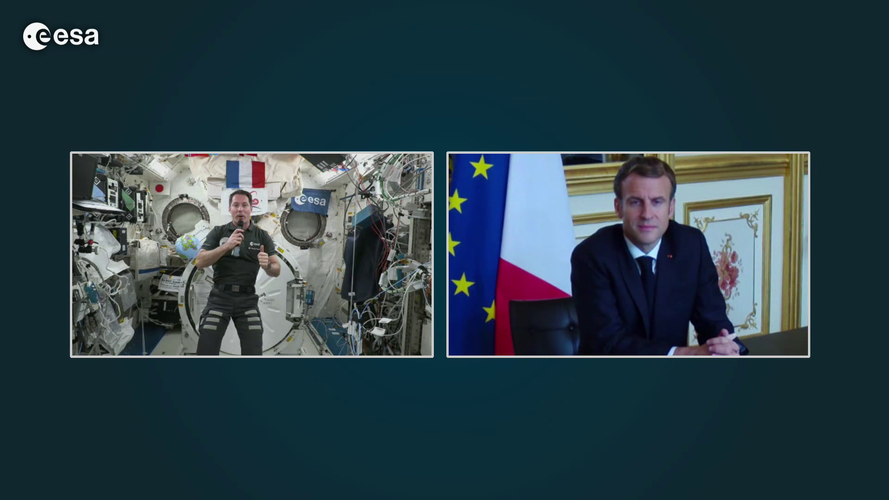
Copernical Team
Explore ESA’s interactive Climate Change Kit

Arguably, humankind has never been more aware of the jeopardy we and the planet face because of climate change. As world leaders at COP26 work to accelerate action towards reducing greenhouse gas emissions to keep the goal of 1.5°C temperature rise within reach, we bring you a new easy-to-use guide on what ESA is doing to understand and monitor climate change from space – data that are essential for policy-makers.
Space Station call with French President Emmanuel Macron
 Video:
00:20:53
Video:
00:20:53
ESA astronaut Thomas Pesquet had a call with the French President Emmanuel Macron on 4 November 2021 from the International Space Station. The call came at the end of Thomas’s second mission to space called Alpha.
Over 200 experiments are planned during Thomas’ time in space, with 40 European ones and 12 new experiments led by the French space agency CNES.
Latest updates on the Alpha mission can be found via @esaspaceflight on Twitter, with more details on ESA’s exploration blog via thomaspesquet.esa.int.
Background information on the Alpha mission is available at www.esa.int/MissionAlpha with a brochure at www.esa.int/AlphaBrochure.
Small but Mighty NASA Weather Instruments Prepare for Launch
 Working together, two instruments could open the door for a more efficient, cost-effective way to gather key information for weather forecasting. Two instruments launching to the International Space Station in a few weeks could be weather-forecasting game changers. The two novel instruments are expected to demonstrate that while they are much smaller, much lighter, and much less expensive than w
Working together, two instruments could open the door for a more efficient, cost-effective way to gather key information for weather forecasting. Two instruments launching to the International Space Station in a few weeks could be weather-forecasting game changers. The two novel instruments are expected to demonstrate that while they are much smaller, much lighter, and much less expensive than w New look for ground-breaking UK-led ESA mission to detect climate change
 TRUTHS, which stands for Traceable Radiometry Underpinning Terrestrial- and Helio- Studies, will provide a gold standard reference for satellites observing the Earth, Moon and Sun.
Conceived by the UK's National Physical Laboratory (NPL) and funded by the UK Space Agency, TRUTHS is being developed by the European Space Agency (ESA). The satellite will be built by the UK space industry led
TRUTHS, which stands for Traceable Radiometry Underpinning Terrestrial- and Helio- Studies, will provide a gold standard reference for satellites observing the Earth, Moon and Sun.
Conceived by the UK's National Physical Laboratory (NPL) and funded by the UK Space Agency, TRUTHS is being developed by the European Space Agency (ESA). The satellite will be built by the UK space industry led On ancient Earth, it never rained but it poured
 Today, we are experiencing the dramatic impacts that even a small increase in global temperatures can have on a planet's climate. Now, imagine an Earth 20 to 30 degrees Fahrenheit hotter than today. Earth likely experienced these temperatures at various times in the distant past and will experience them again hundreds of millions of years from now as the sun continues to brighten.
Little i
Today, we are experiencing the dramatic impacts that even a small increase in global temperatures can have on a planet's climate. Now, imagine an Earth 20 to 30 degrees Fahrenheit hotter than today. Earth likely experienced these temperatures at various times in the distant past and will experience them again hundreds of millions of years from now as the sun continues to brighten.
Little i Better hurricane forecasts with infrared satellite measurements of cloudy skies
 Weather forecast models have long struggled to integrate satellite observations of infrared radiation in cloudy regions of the sky. But in recent years, some satellite data providers have developed new techniques to integrate such data. A group of researchers from China, Japan, the US and the UK have performed a survey of best practice for the observation and use of this data, demonstrating sign
Weather forecast models have long struggled to integrate satellite observations of infrared radiation in cloudy regions of the sky. But in recent years, some satellite data providers have developed new techniques to integrate such data. A group of researchers from China, Japan, the US and the UK have performed a survey of best practice for the observation and use of this data, demonstrating sign China launches remote-sensing satellite group
 China launched a group of remote-sensing satellites from the Jiuquan Satellite Launch Center in northwest China on Wednesday.
The second group of the Yaogan-32 satellite family was launched by a Long March-2C rocket with an attached upper stage at 3:43 p.m. (Beijing Time) and entered the planned orbit.
This was the 394th mission of the Long March rocket series.
span class="BDL
China launched a group of remote-sensing satellites from the Jiuquan Satellite Launch Center in northwest China on Wednesday.
The second group of the Yaogan-32 satellite family was launched by a Long March-2C rocket with an attached upper stage at 3:43 p.m. (Beijing Time) and entered the planned orbit.
This was the 394th mission of the Long March rocket series.
span class="BDL Simulating galaxy formation for clues to the universe
 For all its brilliant complexity, the Milky Way is rather unremarkable as galaxies go. At least, that's how Mark Vogelsberger sees it. "Our galaxy has a couple features that might be a bit surprising, like the exact number of structures and satellites around it," Vogelsberger muses. "But if you average over a lot of metrics, the Milky Way is actually a rather normal place."
He should know.
For all its brilliant complexity, the Milky Way is rather unremarkable as galaxies go. At least, that's how Mark Vogelsberger sees it. "Our galaxy has a couple features that might be a bit surprising, like the exact number of structures and satellites around it," Vogelsberger muses. "But if you average over a lot of metrics, the Milky Way is actually a rather normal place."
He should know. UNI Bremen involved in AMADEE-20 Mars Simulation
 AMADEE-20: That is the name of the simulated Mars mission of the Austrian Space Forum, which was carried out in the Israeli Negev Desert. More than 25 experiments were carried out there. Two projects from the University of Bremen, namely INTERTEAM and MarsLock, were also involved in the research.
b>What are team processes like when the crew is on Mars? br> /b>
The INTERTEAM project addre
AMADEE-20: That is the name of the simulated Mars mission of the Austrian Space Forum, which was carried out in the Israeli Negev Desert. More than 25 experiments were carried out there. Two projects from the University of Bremen, namely INTERTEAM and MarsLock, were also involved in the research.
b>What are team processes like when the crew is on Mars? br> /b>
The INTERTEAM project addre New Curtin study pinpoints likely home of Martian meteorites
 Curtin University researchers have pinpointed the likely origin of a group of meteorites ejected from Mars, using a machine learning algorithm that analyses high-resolution planetary images.
The new research, published in Nature Communications, identified meteorites that landed on Earth likely originated from Mars' Tooting crater, located in the Tharsis region, which is the largest volcani
Curtin University researchers have pinpointed the likely origin of a group of meteorites ejected from Mars, using a machine learning algorithm that analyses high-resolution planetary images.
The new research, published in Nature Communications, identified meteorites that landed on Earth likely originated from Mars' Tooting crater, located in the Tharsis region, which is the largest volcani 